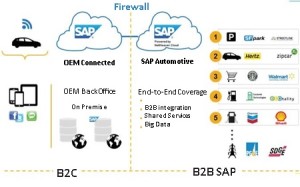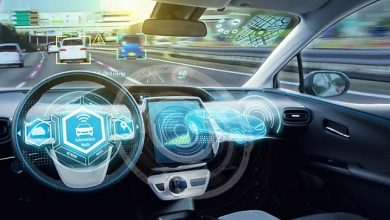Enabling Connected Vehicles
Sudakshina Ghosh
Automotive Industry Director
SAP India

Technology Evolution toward Connected Vehicles of Today and the Future
Cars are evolving from mostly mechanical, metal-based vehicles to a connected set of component platforms, plastics, and next-generation materials. They are essentially becoming a rolling data-center providing safety and entertainment while serving the primary function of going from Point-A to Point-B.
Today’s car has the computing power of 20 modern PCs, features about 100 million lines of code, and processes up to 25 gigabytes of data per hour. Social acceptance of a fully autonomous vehicle and the regulatory environment supporting it is likely 5-to-10 years away based on current forecasts. However, a connected vehicle is here today, in terms of in-car services, data-collection on vehicle-performance and driver-behavior and pushing out value-added services. This convergence of device, data and cloud is being driven by powerful software at the backend, bridging the gap between the user and their gadgets. As the computing capacity of cars develops further, not only is programming becoming more complex and processing speeds becoming faster, but the entire nature of the technology is shifting. While automotive digital technology once focused on optimizing the vehicle’s internal functions, the computing evolution is now developing the car’s ability to digitally connect with the outside world and enhance the in-car experience. This is the connected car – a vehicle able to optimize its own operation and maintenance as well as the convenience and comfort of its passengers using onboard sensors and Internet connectivity.
The demand for connected cars is growing rapidly. Global connected car market revenues are likely to increase 6-fold by 2020 (McKinsey estimate). Driving-centric apps and services are becoming as important as infotainment content in the consumer purchasing process. The current automotive manufacturers focus on providing infotainment delivery (streaming music, social media channels etc.) reflects their desire to meet the expectations of digital lifestyle consumers who are heavy users of smartphones and want to use their favorite apps and services inside their cars. This is a logical first-step, but these consumers will increasingly value apps that are useful and relative to the driving experience.
Traditional Value-chains are Evolving to Make Vehicles Smarter for Digital Consumers
Cars are increasingly being fitted with sensors to capture more and more information and cloud-based connected car service delivery platforms will play a central role by continuously connecting the car and driver to the outside world and managing the data and analytics to power driving-centric apps.
For example, vehicle and driver data can be dynamically stored, updated, and analyzed in the cloud to determine when a vehicle service o?er should be presented to the consumer by a local dealer including a promotional incentive for taking immediate action—a true “win-win” for all involved.
The availability of data due to the connected nature of vehicles during operations is leading to disruptions in automotive business-models. The human-machine interface, car condition data, and dynamic real-time geo-information will become the key control-points in the redistribution of profits in the industry value-chain.
In India, the evolution of the vehicle telematics market is being driven by the following needs:
- Monitoring & routing applications for taxi operators
- Order-delivery tracking
- Call-centers to receive emergency-calls during o?-road incidents and accidents
- Fleet Management for vehicle geo-spatial tracking
- Remote management of LCD-displays in public transport buses and bus-stops
SAP Technology is Scalable and Ready to Enable Smarter, Connected Vehicles Vehicle On-Board Units (OBU), the critical hardware component enabling telematics, are becoming increasingly sophisticated with increasing data-transmission frequency. Data generated by telematics system is the very definition of BIG DATA–putting in place a ready and scalable technology platform is equally important to gain projected business benefits.
IT-imperatives to enable connected vehicles and deliver business-value are as follows:
1. Remote Data Storage Repository: Road, scrub, normalize high volume of data.
2. Data Analytics and Visualization: Turn telemetry and connected-vehicle BIG-DATA into analytics to support business decisions.
3. Predict & Trigger Business: Processes New business models, continuous improvements.
SAP is deeply engaged with early-adopter, innovative customers to enable the connected vehicle vision. Highlighted below are selected high-impact connected-vehicle business-scenarios that SAP has delivered for customers:
1. Vehicle & Driver Diagnostics for individual owners and fleet operators
SAP’s real-time data-platform powered by SAP HANA, the best-in-class in-memory data-base with a rich applications portfolio helps gain visibility into the as-set and drill-down into vehicle and driver-level analytics:
Fleet Owner Dashboard: Geospatial (lat/long) position of vehicles on route, vehicle start & stop times, miles driven, route congestion levels, route fuel consumption trend, route/trip profitability.
View historical route operations: Characteristics e.g. driving conditions and break-down trends.
Vehicle Stats from sensor-data monitoring: Engine performance/diagnostics, tyre health, battery%, oil-levels, avg. speed, driver metrics.
Operating Trend at 8/ 10/ 24 hour intervals
Immediate detection of anomalies and faults: (across transport network).
Drill-down to root-cause: (e.g. engine oil pressure–low coolant–gasket issue) to identify right components to be serviced.
Trigger Accident/Vehicle O?-Road Response: Through process-level integration with call-center operations and service-center proximity/readiness (technician skill-sets, spares availability).
2. Enable Predictive Maintenance through Early Detection and Timely Maintenance
SAP can significantly increase vehicle up-time by delivering reliable and early diagnosis of issues and trigger business-transactions that can rectify them by:
Predicting time-to-failure and work-order execution time: (economic cost of down-time based on route-revenue, customer load/priority).
Routing work-order: To nearest/ best-equipped service center as per route.
Handling re-calls proactively: Return knowledge to product development and quality processes.
3. Optimize Loads and Manage Routes for Higher Operating E?ciency
SAP technology can help determine route-costs based on operational constraints, consolidate loads and optimize fleet-schedule across routes. Ability to predict traffic-density dynamically on the basis of aggregated vehicle routes can enhance route profitability by optimizing time-taken and fuel-consumption.
Deliveries can be scheduled to minimize fleet idle-time and optimize capacity utilization (e.g. empty return loads, less- than-truck-load deliveries) and last-minute orders can be accommodated to balance fleet-capacity to location.
SAP HANA Automotive Cloud Vision: Connecting Vehicles to Eco-system
As vehicles become more connected and operating data is managed digitally, OEMs can be better-positioned to introduce innovative pay-as-you-drive insurance and customized AMC/ maintenance o?ers based on their access to sensor-data, ability to analyze this data and simualte future operating patterns. As connectivity becomes an integral part of an automobile’s value, companies from industries that may have seemed unrelated to the automotive industry just a few years ago will likely become key players. Today’s in-vehicle user computing is dominated by smartphones and applications because embedded connectivity is only present in a small minority of vehicles. SAP’s future vision for the industry is to enable the Connected Car through SAP HANA Automotive Cloud Platform: using cloud technology to transfer information to a car keeping diagnostics and sending to a dealership for accurate repairs.

New business-models will evolve to provide personalized services to drivers based on their location and route. Sap is co-innovating with leading automotive manufacturers such as BMW and Toyota to bring location-based offers and simplified fueling-experience to customers.
The opportunity to innovate based on data and powerful software capabilities is immense as the connected cars of to- day evolve into autonomous self-driven vehicles leading to minimal accidents, low emissions while delivering better experience for consumers.

